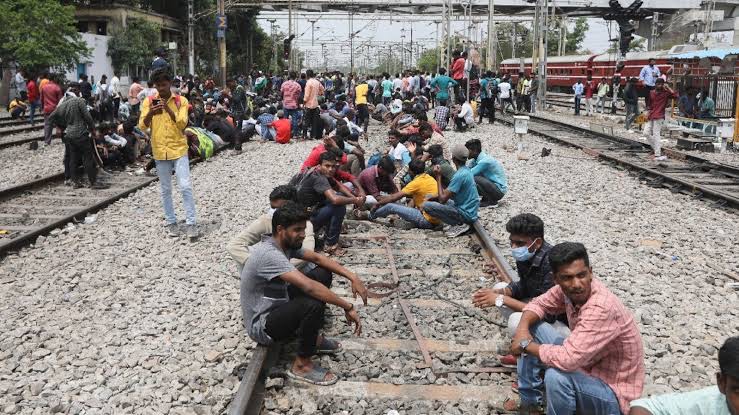
THE New Pension Scheme which is a contribution based Pension Scheme, was introduced for the first time in India for Central Government employees around 2004. The Ministry of Finance (Department of Economic Affairs) through a Notification No. 5/7/2003- ECB & PR dated 22nd December, 2003 made NPS mandatory for all new recruits to the Central Government service (except the armed forces) with effect from 1st January, 2004.
After the enactment of the Pension Fund Regulatory and Development Authority Act (PFRDA Act 2013), the pension scheme notified on 22.12.2003 has become the National Pension System (NPS) under this Act. NPS is now regulated under PFRDA Act, 2013 and regulation framed thereunder by Department of Financial Services and PFRDA.
Several states adopted the NPS for its employees and the Jammu & Kashmir Government too did the same from 2010 onwards. The employees appointed after 2010 in J&K are covered under NPS.
As mentioned above, the NPS was applicable to all the employees except those working in the Armed forces. The Government of India has to keep a huge budget for the pension of ex -servicemen. It is estimated that out of the total Defence budget of India, 25% goes into the kitty of pensioners of Navy, Army and Airforce.
On February 1st this year, while presenting the Union Budget 2022-23 in the Parliament, the Finance Minister Nirmala Sitharaman announced an increase in allocations for the Ministry of Defence (MoD) by 9.8 percent. During financial year 2022-23, India’s Defence budget allocation is USD 54.20 billion (Rs 4,05,470.15 crores) after excluding the component of the Defence pensions and is primarily focused towards the upkeep and modernization of an operational Armed Forces. The capital outlay, which focuses towards the modernization of Armed Forces has been increased by 12.82 percent with an allocation of USD 20.36 billion (Rs 1,52,369.61 crores).
Between financial years 2012 and 2021, defence expenditure increased at a nominal annual rate of 9.5%. Pension expenditure ballooned 14% year-on-year during the same period, while capital outlay spending rose only 8.4%.
The defence advisors of Govt of India are concerned about this issue because if this trend were to continue, the scope for defence modernisation is likely to reduce further over the next ten years . This has panicked the defence policy makers who have realised that optimising available monetary resources is the only option. Agnipath scheme has been envisaged by Govt of India to address this issue especially at a time when India is facing an imminent economic crisis.
Agnipath Scheme and Agniveers
Under the major policy reforms to recruit soldiers and boost the defence footfall, Govt of India recently unveiled its Agnipath scheme. The new scheme will be implemented in the three services, i.e Army, Navy and the Airforce. The Cabinet Committee on Security, the CCS , has already cleared this new recruitment program which will come into force with immediate effect. The soldiers who will be recruited under the Agniveer scheme will be called Agniveers. But unlike the regulars, these defence men will serve the nation under terms and conditions.
Around 45,000 to 50,000 soldiers (Agniveers) will be recruited annually under this scheme. This year the Govt plans to recruit around 46000 soldiers across India. The aspirants have to be between the ages of 17.5 years and 21 years. The recruitment will be done twice a year through rallies and basic criteria will be the same as laid down for regular recruitments. After selection, the Agniveers will be trained for six months and then deployed for three and a half years (total 4 years). During service, these soldiers will be paid a monthly salary of Rs 30,000 per month, along with additional benefits which will go up to Rs 40,000/month by the end of the four-year service.
The Government of India claims that this scheme will create a much more youthful and technically adept war fighting force by ensuring a fine balance between youthful and experienced personnel in the armed forces. Out of the total recruited Agniveers, only 25 % will be allowed to continue for another 15 years under permanent commission. While this would reduce the total manpower in the permanent force levels, it will also bring down the expenditure on salaries and pension to a great level. The Defence Minister Rajnath Singh reportedly denied concerns of decreasing the pension bill:
“We never see the Armed Forces through the perspectives of savings. Whatever we need to spend, the government is willing to spend. Our aim is to defend the country’s borders. Whatever needs to be spent, will be spent.”
Other Facilities
The Agniveers will be granted leaves at the discretion of the respective Armed Forces. The soldiers will be eligible for 30 leaves per year and sick leave based on medical advice. During their 4 year tenure as Agniveers in the Armed Forces, they will be entitled to the medical facility at Service Hospitals as well as CSD provisions. The regulations make sure Agniveers don’t leave the Armed Forces before completing the 4 year tenure but in exceptional cases the Competent Authority may allow it depending on the gravity of the situation.
As explained, Agniveers will get Rs 30,000 per month salary for the first year, and it will increase in subsequent years. 30% of the salary will be deducted as a Contribution to the Agniveer Corpus Fund (ACF). The amount accumulated by the Agniveers at the completion of the tenure will be matched by the government, and Agniveers will get approx Rs 11.5 lakhs in hand as a Seva Nidhi (retirement) package. The amount that Agniveers get under Seva Nidhi will be tax-free. In addition to this,the Agniveers will get non-contributory life insurance of Rs 48 lakh that would be paid to the family in case of death of Agniveer while on duty. Agniveers are not supposed to pay any amount towards Provident Fund (PF).
Protests against Agnipath scheme
Soon after the Govt made an announcement to launch the Agnipath scheme, massive protests erupted in Bihar, Rajasthan, MP, Punjab ,Telangana , UP and some other states against the recruitment scheme. Most of the protesting youth are those aspirants who were preparing for getting into Army, Navy and Airforce in the coming months but the new recruitment scheme Agnipath seems to have shattered their dreams as the recruitment is only a 4 years contract and only 25% among them would continue to be in the armed forces for next 15 years. These agitating youth disrupted rail and road traffic in several states and torched rail coaches. The agitation turned violent in Bihar’s Munger and Jehanabad as agitators burned tyres, damaged public transport , cars, buses and set trains on fire while raising slogans against the scheme.
Some changes in scheme
As protests over Agnipath scheme became violent, the Govt has decided to make some changes in the scheme including keeping 10% reservations for the ‘Agniveers’ in various Central government jobs. The announcement was made on June 18 by the Union Ministry of Home Affairs (MHA) on Twitter.
The Agniveer soldiers who will be recruited under the newly launched scheme, are already entitled for job reservations in the Ministry of Defence, Indian Coast Guard and Defence Civilian posts, and all the 16 Defence Public Sector Undertakings.
Apart from this, the age limit for recruitment during the first year has also been raised from 21 years to 23 now after protests.
The Ministry of Home Affairs (MHA) also announced a three-year age relaxation beyond the prescribed upper age limit for Agniveers for recruitment in Central Armed Police Forces -CAPF and Assam Rifles. The upper age limit for recruitment in Central Armed Police Forces (CAPFs) – inclusive of Border Security Force (BSF), Central Reserve Police Force (CRPF), Central Industrial Security Force (CISF), Indo-Tibetan Border Police (ITBP), Sashastra Seema Bal (SSB), National Security Guard (NSG) and Special Protection Group (SPG) – will now stand at 26 years for Agniveers. In addition, Agniveers will get a compensation of Rs 1 Crore in case he sacrifices his life in the service of the nation.
J&K Chapter
Following suit in the backdrop of the raging protests over the youth-engaging scheme, Lieutenant Governor Manoj Sinha announced 10 per cent reservation for Agniveers in the Jammu and Kashmir Police.
The announcement was made in the 16th edition of the ‘Awaam ki Awaaz’ program. While addressing the monthly program, which is aired on all locals and primary channels of All India Radio (AIR) in the Union Territory, LG Sinha also considered suggestions for coaching facilities to the aspirants.
The LG said his decision was based on the suggestion given by two youth from Jammu – Sankarshan Sharma and Akarshit Sharma.
“Sankarshan and Akarshit, I want to thank you for your suggestion. I want to tell you that we will implement the 10 per cent reservation for Agniveers with immediate effect,” the LG said.
Sinha instructed officials of Mission Youth, district administrations and top police officials to provide necessary facilities to all the youth preparing for the four-year Agniveer military recruitment scheme via various training programmes.
The move is seen as a major boost for youth intending to join as ‘Agniveers’ in 3 Services. The LG also agreed to consider suggestions for coaching to the aspirants.
Conclusion
At a time when non BJP states like Rajasthan and Chhattisgarh have already restored the Old Pension scheme and states like Punjab, Tamil Nadu, and Jharkhand, are also preparing to implement the same, the Govt of India should have put in more thought into the Agnipath Scheme. However, as pension bills are huge in the Defence Ministry (25% of defence budget), the Govt is also under compulsion to address this issue by introducing a Agnipath scheme which is nothing but Non Pension Scheme which was not applicable to Defence personnel till date. As the scheme has now been introduced for appointment of soldiers at lower rung, will the Govt introduce this scheme to recruit the officers in defence service as well?
- Views expressed in the article are the author’s own and do not necessarily represent the editorial stance of Kashmir Observer
Follow this link to join our WhatsApp group: Join Now
Be Part of Quality Journalism |
Quality journalism takes a lot of time, money and hard work to produce and despite all the hardships we still do it. Our reporters and editors are working overtime in Kashmir and beyond to cover what you care about, break big stories, and expose injustices that can change lives. Today more people are reading Kashmir Observer than ever, but only a handful are paying while advertising revenues are falling fast. |
| ACT NOW |
| MONTHLY | Rs 100 | |
| YEARLY | Rs 1000 | |
| LIFETIME | Rs 10000 | |










